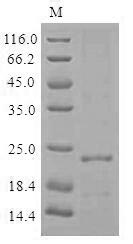The production of this Recombinant H. pylori C17orf99 protein began at the genetic level, where the coding sequence for the C17orf99 protein was first isolated and cloned into an expression plasmid vector. Recombinant DNA technology was used in the process. Next step was cloning. The expression vector must be introduced into the host cell (Baculovirus) so that the cells could be cultured and expressed the desired ftnA protein. And we finally got the recombinant ftnA protein with the purity of 85%+ determined by SDS-PAGE.
Ferritin A (FtnA), a major iron storage protein in E. coli, can scavenge the iron released from the disrupted iron–sulfur clusters and alleviates the iron-mediated production of hydroxyl free radicals in the presence of hydrogen peroxide. Ferritin minerals are nutritive iron concentrates that slowly release the iron for use in the synthesis of new iron centers for protein catalysts as in heme, iron–sulfur clusters, or iron bound entirely by protein in amino acid side chains (“non-heme iron”). Iron-containing proteins are key to electron transfer chains in respiration (heme proteins) and photosynthesis (iron–sulfur proteins) and play important roles in hydroxylation reactions. The iron stored in FtnA can be retrieved by IscA for the iron–sulfur cluster assembly in IscU in the presence of the thioredoxin reductase system. The physiological roles of ferritins in cellular response to oxidative stresses and in repair of the disrupted iron–sulfur clusters have been identified. Increasing evidence indicated that ferritins, a large family of iron-storage proteins found in bacteria and mammalian cells may have an important role in cellular defense against oxidative stresses.






